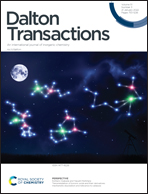Newly synthesized palladium(ii) complexes with aminothiazole derivatives: in vitro study of antimicrobial activity and antitumor activity on the human prostate cancer cell line†
Abstract
Five new complexes of the palladium(II) ion (C1–C5) having the general formula [(PdL2)]Cl2 with some 2-aminothiazoles (L1–L5), where L1 = 2-amino-4-(3,4-difluorophenyl)thiazole, L2 = 2-amino-5-methyl-4-phenylthiazole, L3 = 2-amino-4-phenylthiazole, L4 = 2-amino-4-(4-chlorophenyl)thiazole, and L5 = 2-amino-4-(2,4-difluorophenyl)thiazole, have been synthesized and characterized by elemental microanalysis and infrared, 1H NMR and 13C NMR spectroscopy. The in vitro antimicrobial activity of the five ligands and the corresponding Pd(II) complexes is investigated. Testing is performed by the microdilution method and the minimum inhibitory concentration (MIC) and minimum microbicidal concentration (MMC) have been determined. Testing is conducted against 11 microorganisms (nine strains of pathogenic bacteria and two yeast species). The tested ligands and palladium(II) complexes show selective, high and moderate activity. There is a difference in antimicrobial activity between the ligands and the corresponding palladium(II) complexes. The complexes have significant anti-staphylococcal activity and activity on Pseudomonas aeruginosa which is better than the positive control. The interactions of newly synthesized palladium(II) complexes with calf thymus DNA (CT-DNA) were investigated using UV-Vis absorption and fluorescence spectroscopy. Analysis of UV-absorption and fluorescence spectra indicates the formation of a complex between the palladium(II) complexes and DNA. The high values of intrinsic binding constants, Kb, of the order 104 M−1 and Stern–Volmer quenching constants, KSV, of the order 105 M−1 indicated very good binding of all complexes to CT-DNA. Also, the new Pd(II) complexes show high cytotoxic activity towards the human prostate cancer cell line and insignificant activity towards non-cancerous human fibroblasts. Future research could additionally explore the biological activity of Pd(II) complexes presented in this paper and investigate the possibility of their implementation in clinical practice.



 Please wait while we load your content...
Please wait while we load your content...